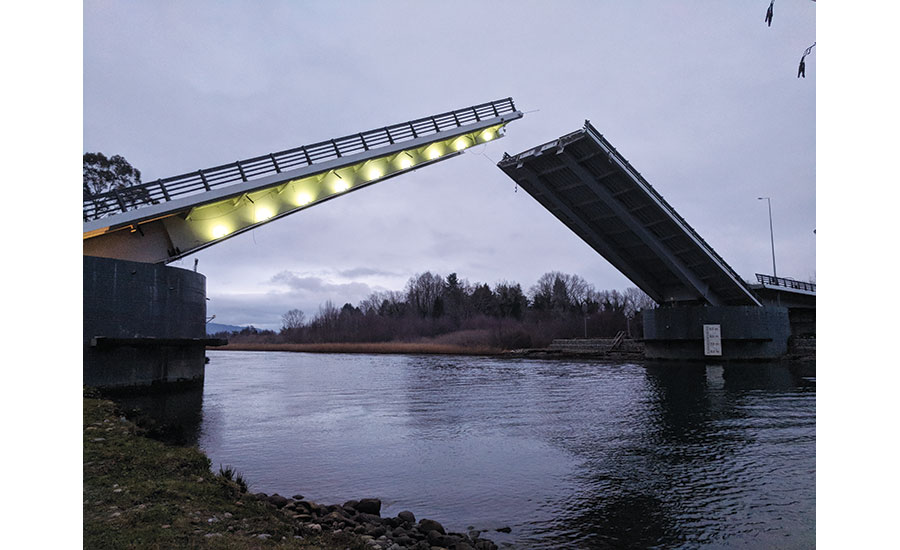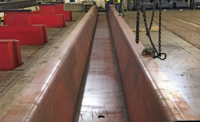An American engineering firm is helping “unstick” a Chilean bridge of national significance that many thought was beyond repair. The 363-meter-long, 14-m-wide moveable bascule bridge’s two lifting sections—each 45 m long and weighing 720 tonnes—had been kept frozen in place at 35° since 2015.
Construction finished in 2014, but a cylinder failure in 2015 rendered the bridge unusable.
“The bridge is the first of its kind in Chile,” says Alberto Abalo, a civil engineering consultant to the Director General of Public Works for the Chilean government. “The city of Valdivia is surrounded by rivers. There is a need for bridges to connect the region.”
Construction finished in 2014, but a cylinder failure in 2015 rendered the bridge unusable. “The highway department decided to leave it up, and the new government last year decided to reevaluate," says Abalo. “There was a diagnosis performed by Modjeski and Masters, and they recommended rehabilitation.”
Azvi, the contractor that built the $30-million bridge, contends that the problem lay in the design. Reports indicated possible fabrication problems that led to additional steel welds on the deck, altering the overall geometry.
Chilean engineers say at least one of its traffic decks was installed incorrectly, making it unusable. Last year, the government issued an RFP “to see if anyone could come up with a way to salvage the bridge,” says Kevin Johns, head of Modjeski and Masters’ movable bridge practice. “We went down and won that contract to investigate the possibility of rehabilitation.”
A New Angle
The bridge is pushed open and closed by two hydraulic cylinders. During testing, one cylinder failed. Construction errors had apparently caused the roadway surface to misalign between the two bascule leaves. “Somehow during construction, the one half of the double-leaf bascule orthotropic deck rotated so that nothing lines up when you close the halves,” Johns says.
After investigations and analysis, the firm helped the government implement a temporary plan that would let the bridge open and close once a month for marine traffic and cars. The bridge is so crucial to the region that the president of Chile attended roadway's opening to traffic for the first time, says Johns.
“Now we’re in a phase where we’re designing more permanent repairs … we determined it was significantly less expensive to repair instead of replace. Our plan will allow for truck traffic and for the bridge to open and close at will,” he says.
According to reports from local experts, “the trunnion bearings were much smaller than we’d have designed and not operating as intended,” says Tyler Miller, mechanical engineer with Modjeski and Masters. “They were not rotating about the bearing surface but between pins and supports on a couple [of areas]. Typically we locate trunnions close to the center of gravity. Here, the center of gravity is far away from trunnions, so that had a huge impact on the machinery.”
In general, hydraulic cylinder operated bridges are designed to remain span heavy during the entire operation.
The bridge was originally intended to be raised to almost 90°. “Typically on a hydraulic cylinder-operated bridge, it’s recommended up to 35°,” says Miller. “[The government] approved the clearance we achieved at 35° for permanent rehabilitation. An 18-meter-high, 35-meter-wide clearance is required. We felt we could raise it to 45°." So Modjeski and Masters recommended that the maximum raised angle be changed to 45 degrees to limit the amount of operation that was not in a span heavy balance condition.
Miller adds that “we never got details on the control system to know how it would’ve reacted at or during the failure. Most of the reports focused on the failed cylinder. Looking at the hydraulic circuitry, we noticed things were done in the layout that were not recommended. They had a sophisticated system to make sure both cylinders operated at the same stroke. Each cylinder has its own control valve. A laser system can monitor the stroke of each cylinder and give feedback to the control system.”
Based on Modjeski and Master’s findings, the government plans to issue bids for a rehabilitation later this year. “This idea of only opening the bridge to 45° had not been discussed prior,” says Johns. “We found a way to fix a bridge that numerous people said couldn’t be fixed. There are going to be things they have to live with and inspect frequently. It’s still better than complete replacement.”





Post a comment to this article
Report Abusive Comment